ATVs, or All-Terrain Vehicles, come with a Vehicle Identification Number that you can use to check their past history from records in DMV, law enforcement, auction sites, and other databases. With this insight, you can easily tell if the ATV has ever been reported as stolen, or if it suffered moderate to severe accidents.
Knowing the background history going back to when the ATV left the plant will inform your purchase decision and potentially save you from headaches brought on by problematic units.
It's an all-terrain vehicle equipped with a straddle seat, handle-bars for steering, and at least 3 or 4 wheels. The vehicle can traverse various terrains, unlike other vehicles, which are limited in their capabilities.
Other names for ATVs include three-wheelers, quadricycle, quad bike, 4-wheeler, light utility vehicle, or four-tracks.
ATVs are developed in two different forms - the Solo model and the Dual version. The Solo style is meant to hold only one rider, while the Dual model provides space for both a driver and a passenger.
These vehicles fall into two categories:
ATVs are rarely permitted on public roads in most places in the US, Canada, and Mexico. In states that permit ATVs on public roads, there are exceptions on who can drive them and they have to fulfill certain requirements to become street-legal, like having headlights and taillights.
They are manufactured by a range of companies, from large and well-known to specialized businesses. Some of the brands you may come across in the US and Canada are:

All ATVs, no matter the brand, contain a standardized Vehicle Identification Number with 17 characters. It consists of capital letters ranging from A to Z and numbers from 1 to 0. The letters I, O, and Q are not used to avoid confusion.
Every letter in this code can provide some specific information. For instance, the following character position table shows what information you can get:
| Character Position | Meaning |
|---|---|
| 1st | Origin country |
| 2nd | Manufacturer code |
| 3rd | Vehicle type |
| 4th – 8th | Model/ Engine type/ Body style |
| 9th | Check digit (Derived mathematically to confirm VIN's authenticity) |
| 10th | Model Year |
| 11th | Plant location in the country |
| 12th – 17th | Unique Serial Number of the Vehicle |
The characters are read in sequence.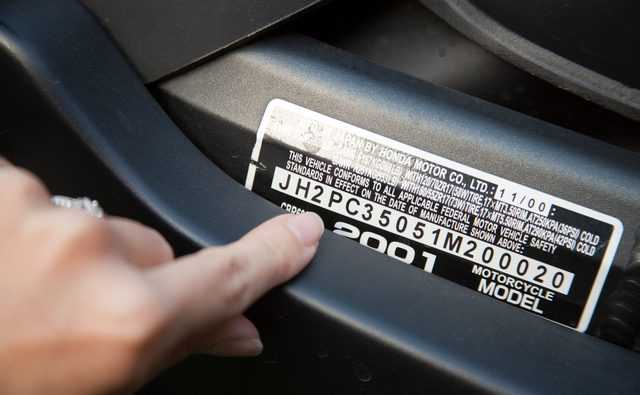 For instance, the first three (origin country, manufacturer code, and vehicle type) are referred to as the World manufacturer identifier. The digits 4 to 8 are the vehicle description code.
For instance, the first three (origin country, manufacturer code, and vehicle type) are referred to as the World manufacturer identifier. The digits 4 to 8 are the vehicle description code.
Without reference charts showing what each letter represents based on its position in the sequence, reading the VIN is pretty much impossible.
Messing with reference charts can be too time-consuming. That's why a better way to read the VIN is using an ATV VIN check tool programmed to decipher the unique string.
Why is ATV VIN lookup so important? Well, it can tell you the basics about how the ATV was configured by the manufacturer. With a history check comprising information pulled from vehicle databases, you can peer into the past, and find out more about the ATV's track record and if it has ever suffered major incidents like thefts or accidents. That is why it is important to use ATV VIN lookup.
Characters 4 to 8 contain the engine, trim, transmission type, and body-style specifications of your ATV. You can similarly find out about the model year and the plant location.
You can similarly find out about the model year and the plant location.
The spec details can help with ordering parts or figuring out if the ATV was modified in any way. You can similarly research common mechanical problems associated with the make, and this may aid you when performing the mechanical inspection. Knowing the make and year is also handy for researching what similar models are selling for.
An ATV VIN number check can reveal prior reported accidents. They make it into the report if they were reported by law enforcement agencies, DMVs, and even repair facilities. You can also tell if the ATV has a prior record of damages and accidents if it has a salvage auction record, or if its title was branded as Rebuilt, Recovered, or Junk. Fourwheeler VIN check will help to find major repairs can also offer hints if there was significant damage to any parts.
From American Honda to Polaris, manufacturers regularly recall certain models because of production defects and safety issues.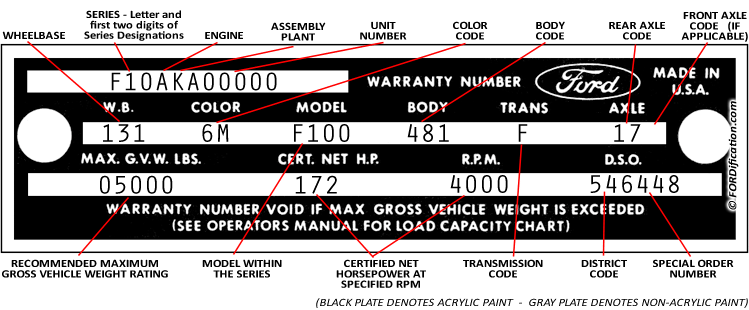 If there are any recalls on the model, the UTV VIN check report will hint at it, as checks are made against databases maintained by manufacturers and government agencies. Knowing about a past recall can allow you to find out if the issue was inspected and fixed, or if it poses a continued danger.
If there are any recalls on the model, the UTV VIN check report will hint at it, as checks are made against databases maintained by manufacturers and government agencies. Knowing about a past recall can allow you to find out if the issue was inspected and fixed, or if it poses a continued danger.
Not all ATVs have odometers. But for models with one, the mileage is disclosed during titling and this happens every time ownership changes hands or during registration renewals. The UTV VIN lookup report will show the last reported readings in chronological order. You can easily spot any inconsistencies as some sellers may reduce the mileage to sell the ATV for more money as low mileage indicates that it was rarely used.
The service history documents the major repairs and maintenance done on the ATV. Service entries are not too frequent as they rely on reporting from service providers. If they are present, you can determine if the owner took good care of the ATV.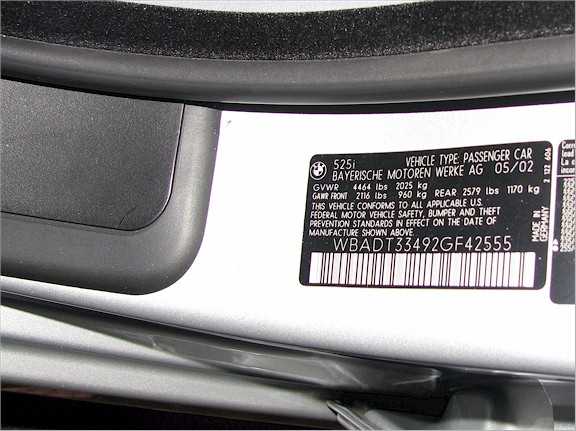 You can see if there are any recurring issues that keep showing up in the service record beyond the norm.
You can see if there are any recurring issues that keep showing up in the service record beyond the norm.
Each report contains information about the current status of the car theft, as well as the history of theft, if any. But consider the possibility that the owner may have not discovered that their ATV is missing. Watch out for other signs that may indicate that the ATV may be stolen, for instance, the price may be too low than the actual value. The seller may fail to produce a title. Additionally, their name may fail to match the name on the title.
Finding it is not so obvious as spotting it on your daily driver, where you'll typically find it on the windshield or door jambs.
On ATVs, it's mostly partly hidden or covered with body components. But you can find it with a little bit of effort. Obviously, manufacturers don't want to expose the VIN to the elements and have it wear down too quickly.
Now, here are places to check depending on your model:
Arctic Cat stamps the number on the frame, but the placement may vary:
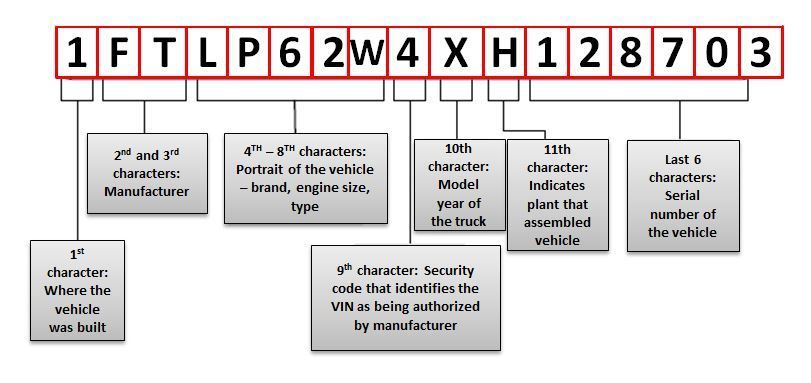
VINs for Honda ATVs are on the front cross member, behind the front rack. If you have custom skid plates installed, they can make it a bit harder to access the code. You may need to unravel the skid. Here are other placements for other popular Honda ATV models:
Like other ATVs, the code location on Yamaha may vary based on the year and model. The most common placement on the majority of Yamaha is on the frame.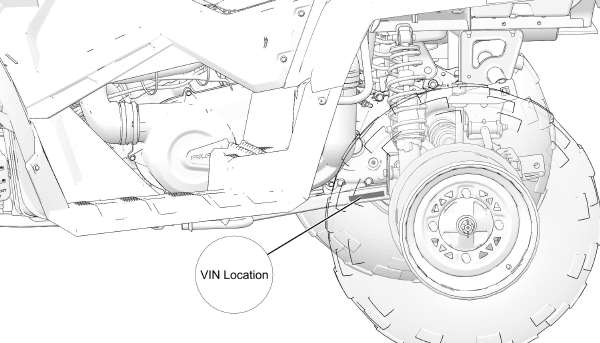 Some other places to check include:
Some other places to check include:
The make, model year, and target market will determine the VIN location on a Suzuki ATV. For easier identification, use the following table:
| Suzuki Model | VIN Location |
|---|---|
| LTR 450 | On metal bar near the frame next to kicker area |
| Eiger | On left rear cross member along the mud wing |
| 250 Quadrunner | On the right rear bar near the taillight |
| 300 King Quad | On the small flat plate. You can see it on the left rear frame member standing vertically |
| 700 king Quad | Left rear frame, at the back of the wheel |
| QuadSport Z90 | On the left rear side of the frame |
| Vinson 500 | Right rear frame, in between tire and fender |
| QuadSport Z90 | On the left rear side of the frame (model number will on the right rear) |
Polaris quads from 1985 and newer models have a 17-digit number. The following table describes the placement of different Polaris models:
The following table describes the placement of different Polaris models:
| Polaris Model | VIN Location |
|---|---|
| Trail Boss | Front wheel well |
| Scrambler | Front wheel well |
| Outlaw | Front wheel well |
| Trailblazer | Front left wheel well |
| 2011 Polaris Hawkeye | Front left wheel well |
| 2013 Polaris Hawkeye | Left rear frame |
| Sportsman 550, 850, 1000 & XP | Front left wheel well |
| Sportsman 400, 450, 500, 700, 800 & ETX | Left rear frame |
| Sportsman 6x6 | Right rear wheel well |
E-Trons will have an identification and engine number. For the code, check under the front fender for a plate affixed between the main frame rails.
For Can-AM off-road ATVs, the VIN placement varies also based on the model year:
For 2017 Can-Am Outlander and Outlander Max all-terrain ATVs, you can also check for the number under the seat in the middle.
Kawasaki ATVs will have the VIN location illustrated on the owner's manual on the first pages. The placement tends to be a bit standardized with this manufacturer, and you'll typically find it on the left front frame rail behind the wheel.
You'll receive a free ATV VIN look up report from FAXVIN by simply entering the identification number in the checker tool, and clicking "Next". But this report only includes what can be read from the VIN itself. There is no information from external databases, and therefore, no details about its past life. The tool is still useful as you can quickly check the specs on various ATVs you may be considering. Afterward, you can order the paid reports for your top favorites. You also get a discount if you're ordering more than one report.
The tool is still useful as you can quickly check the specs on various ATVs you may be considering. Afterward, you can order the paid reports for your top favorites. You also get a discount if you're ordering more than one report.
You may have sat back and wondered: Which is the best all-terrain vehicle to buy? An ATV or UTV, and what are the differences between them?
Starting off, an ATV has four wheels, a straddle-style seat, and handlebars like a motorcycle for steering. Class 1 ATVs only have one sitting position for a single rider. Class II vehicles have an extra seat for the passenger at the back and will be a bit wider.
A UTV is like a bigger version of the ATV, but with certain differences. It has a steering wheel for control and at least two seats like a car. Two people can sit side by side, earning its common nickname, "Side-by-side" vehicle. Some UTVs feature up to four seats. They also have a rollover cage and roof, unlike ATVs. As they are more powerful and bigger, they have a lot of utility uses.
Buyers should consider the following factors to determine which is the best version for them:
The UTV report is no different from the ATV check, all the same data and checks are present. You can see the manufacturer specs as well as any reported history such as title changes, recalls, odometer readings, and accident/salvage records.
Using our VIN lookup for ATV is quite intuitive, and you don't need any special skills. On this page, you can find the number entry box by navigating to the top. The next steps include:
You don't need to pay anything to get started with a free ATV VIN check. Enter the number and instantly get the vehicle's specs including the model year, trim, color, and more.
Do ATVs Have VIN Number?
All ATVs and UTVs built in and after 1981 have a standardized 17-digit identification number used by other vehicles as well.
How long is the VIN number on an ATV?
It has up to 17 characters, consisting of letters and numbers.
What Year is My ATV by VIN?
The 10th character represents the model year. It's either a letter or a number. For instance, A=2010, B=2011, J=2018, K=2019, L=2020, and P=2023. You can use a VIN year chart to easily determine the model year.
StateofFlorida.com is not affiliated with, owned, or operated by the State of Florida and is not endorsed or approved by the State of Florida. Visit MyFlorida.com
If you need to find information about a vehicle's history, start by checking government records kept by the Florida Department of Highway Safety and Motor Vehicles (FLHSMV).
Using the license plate number or Vehicle Identification Number (VIN), you can access details about ownership history and find out if the vehicle has a lien on it. Visit FloridaDrivingRecord.com to request an official vehicle status report.
You can also enter a vehicle's license plate number on the website to determine if the tag is registered to a different vehicle. The report lists the VIN, year, make and model of the vehicle associated with the plate number.
If you need to review documentation on a boat or another vessel, you can search for records by entering the vessel's name or official U.S. Coast Guard identification number on the National Oceanic and Atmospheric Administration website.
The vessel documentation you will receive lists a wide range of identifying information, including the vessel's current name, previous names, home port, owner, hull number and more.
If you are considering buying a used car, truck, RV, boat or another vehicle, it is a good idea to check for a clear title before you pay. A clear title means there are no liens held against the vehicle or vessel.
Liens allow banks or other creditors to seize vehicles from owners if they do not repay their debt. If there is a lien on a used vehicle you want to buy, the seller must pay off the lien before transferring the title to you.
Vehicles or vessels may have a lien for a variety of reasons. When the original owner of a vehicle has not paid off the loan that he or she took out to buy it, the bank or lender can put a lien on the vehicle.
People can also offer their vehicle as collateral for a cash loan, usually at a payday loan establishment. These are known as title loans. Another type of lien is a mechanic's lien, which auto mechanics can place on a vehicle when the owner does not pay for repairs.
No. Never buy a vehicle without a VIN because there is a possibility that the vehicle is stolen. There may be some valid reasons for a vehicle to be missing a VIN; however, it is best for the seller to resolve the issue with FLHSMV before you purchase the vehicle.
Instead of using a VIN for identification purposes, most boats have a hull identification number (HIN). Boats manufactured before 1972 were not required to have a HIN assigned by the manufacturer, and homemade vessels do not have a HIN.
However, FLHSMV requires all registered and titled vessels to display a HIN. If your vessel does not have a manufacturer's HIN, the FLHSMV will assign one.
No, there are some exemptions. The main exception is for nonmotorized powered vessels less than 16 feet in length. If a vessel is exempt from titling and registration, then you won't be able search for that vessel's record, even if it has a HIN. Visit the FLHSMV website for a complete list of exemptions.
Businesses that routinely check vehicle records can receive discounted pricing on Florida motor vehicle status reports at FloridaDrivingRecord.com.
MegaZip
Search Order 0 pcs in the basket 0 r.
All the girls in the little Peugeot do it...
Everyone looks up the VIN from time to time. And not only in Peugeot, but also in Toyota, Nissan and even in a big black Mercedes. Sometimes you can find it right away, and sometimes you have to work hard. After all, the treasured tablet is sometimes hidden in the most unexpected places. Therefore, my article will be useful to all those who are faced with the search for VIN for the first time, and especially to the beautiful half of humanity.
For lovely ladies driving:
For brave ladies on bikes:
Experienced VIN searchers will smile, many will say: “Yes, we know it all!”.
“Well, great!” I will answer. Feel free to put a finger up, share the article with friends, familiar motorcyclists and autoladies, and then wow!!! CLICK HERE AND WE ARE IN THE CATALOGS OF SPARE PARTS!
If you decide to refresh your knowledge or just switch your thoughts from everyday worries and read - welcome under the cut!
VIN (Eng. Vehicle Identification Number) is a unique vehicle code consisting of 17 characters. The code provides information about the manufacturer and characteristics of the vehicle, as well as the year of manufacture. The structure of the code is based on ISO 3779-1983 and ISO 3780 standards. Identification numbers are applied to integral parts of the body or chassis and on specially made number plates (nameplates).
In other words, VIN (hereinafter we give the term more commonly used in the Russian Internet - VIN) is a set of characters that identifies a car or motorcycle and tells all the information about it. Each vehicle is assigned its own unique code, which is not repeated on other vehicles. Like a human DNA code.
And here they are - special number plates:
Yes, I would like to separately note that in place of the VIN code your vehicle may have a body (frame) number. It usually consists of 10-13 characters and looks like this on a car plate:
or like this on a motorcycle:
The frame number, like the VIN, serves to identify the equipment, although it carries less information . The characters in this number are written with a hyphen. The first part carries information about the type and brand of the vehicle, and the last 5-8 digits indicate the serial number (the order in which the equipment left the assembly line).
Body/frame number mostly found on vehicles for the Japanese domestic market. You have probably come across beautiful letters JDM more than once on loud tinted cars or in publics dedicated to drifting, tuning and various sports related topics. This abbreviation just means Japanese Domestic Market - Japanese Domestic Market.
JDM technology has a very large army of fans around the world, and Russia is no exception. On the World Wide Web you can find a lot of information, as well as fan clubs, workshops, tuning studios that have dedicated themselves to serving the style of the Japanese Domestic Market.
First of all, of course, let's look at the registration documents for our equipment. For a car and a motorcycle, the PTS (vehicle passport) serves as an “identity document”. Here it is:
In this example, the VIN is indicated in paragraph 1, and in paragraph 8 it is duplicated as the body number. But there are TCPs where the VIN is affixed in paragraph 7 or 8, and in paragraph 1 (VIN) it is indicated "NONE".
If you are a happy owner of a snowmobile or an ATV and want to find the VIN, take the PSM (passport of a self-propelled vehicle) and find the item “factory number of the vehicle (frame)”:
I think everything is clear here. Dealt with documents. Let's learn how to look for VIN directly on the vehicle itself.
CARS
Depending on the country of manufacture, the identification number may be located differently. As a rule, the VIN is duplicated in different places or can even be applied to all the main elements of the body. This makes it easier to find it and at the same time more reliably protect equipment from illegal actions.
VIN can be stamped either directly on the body (frame) or on a special number plate attached to the body with rivets. Most modern cars (especially for the US market) have a VIN, which is located in a special window under the windshield. It can be seen without opening the hood:
The number is usually duplicated on a sticker that can be found on the pillar or threshold in the driver's door opening.
VIN is often marked on an iron plate located under the hood in a conspicuous place:
Or stamped directly on the car body in the place of the partition between the engine compartment and the passenger compartment:
On cars with a frame body structure, VIN is often applied to the side members:
Another common place is on the floor in front of the driver's seat .
Move the seat as far back as possible and fold down the mat:
0003
On some vehicles, the VIN plate is in the trunk, in the spare wheel compartment:
MOTORCYCLES
also on the right)
In the place of the steering joint, the VIN is knocked out directly on the frame:
And duplicated on the plate:
Some manufacturers (BMW, in particular) place the VIN on their bikes a little differently:
and like this:
VIN on maxi scooters is usually stamped on the frame, as shown:
ATVs
Here are the most popular places:
On the plate under the seat:
On the frame behind the front wheel:
At the bottom of the frame:
Front of the frame:
0003
On the CVT housing:
SNOWMOBILES
Traditionally, the VIN is stamped on snowmobiles on the frame on the right side of the tunnel, there is also a plate on which the identification number is duplicated. In addition, on many models, the coveted combination of letters and numbers can be found under the seat.
On the “tunnel” on the right:
Under the snowmobile seat on the plate:
Now that we have clearly familiarized ourselves with the locations of the identification number, I offer a small life hack to find the treasured place. As a rule, each user manual begins with pictures showing where the numbered units of the equipment are located. If you have such a booklet in printed and electronic form (you can find it on the World Wide Web) - open the first pages, look at the indicated place, and voila - the quest is completed!
Here's how it looks in my manual:
In place A we move the driver's seat back, bend the mat (maybe you will need to open the cover) and see the VIN, which is stamped directly on the body; in place B, open the hood and find the VIN on a metal plate.
BACKGROUND
The identification number can reveal a lot of useful information about a vehicle. Before buying, the future owner will be able to find out the real mileage, the number of former owners, find out if the equipment was involved in an accident, if it was stolen, and if there are any restrictions on registration actions.
Currently, it is possible to scan and recognize codes using both special scanners and various mobile applications that use the camera. You can also check by VIN code using one of the many online services.
SELECTION OF PARTS AND ACCESSORIES
It's no secret: in the search and selection of spare parts, the identification number is assistant No. 1.
It allows:
If you find it difficult to do this or want to save precious time, please write to our technical support.
Thank you for reading to the end, I'm sure the article was useful to you!
The number and marking of the engine is knocked out on the left half of the crankcase, in a place specially designated for this, in the form of a platform.
You can find this site in the following way:
Approach the scooter from the left side, look at the variator cover, the platform is located under the variator cover in its front part.
Approach the moped from the left side, look at the left engine cover, the platform is located under the cover in its rear part.
152QMI, 1P52QMI, 157QMJ, 1P57QMJ - this is how 4T CVT-type engines with a displacement of 125cc to 180cc are marked, these include scooter models such as Irbis (Nirvana, ZRX, ZRS, Grace, Skynet), Griphon (Galaxy150, Rocket150, Saturn150, Racer150), ABM (Flash, Volcan, Vortex), Atlant (Storm, Adrenalin, Calypso), Omaks (Purga, Classic, Falcone), Honling, and quads…
153QMI, 1P53QMI, 158QMJ, 1P58QMJ - this is how 4T CVT engines are marked, these include scooter models such as Stels (Tactic150, Vortex150), Keeway .